 Image search results - "kokugikan" Image search results - "kokugikan" |

Ryogoku Kokugikan sumo arena as seen from Ryogoku Station
|
|

The Kokugikan as seen from JR Ryogoku Station platform.
|
|

More people than the real tournamentAbout 8,000 people took time out from their Golden Week holidays to see this official sumo practice of all sumo stables.
|
|

Crowd outside the Kokugikan await their favorite wrestlers.
|
|
|
|

Crowd enters the Kokugikan for Musashimaru's retirement ceremony on Oct. 2, 2004.
|
|

Yokozuna Deliberation Council membersIn the middle is Kitanoumi.
|
|

Passing out programs
|
|
|
|

Musashimaru at the entrance
|
|

Sumo elders in the front row
|
|

Musashimaru greets the crowd
|
|

Former yokozuna Taiho, Takanosato, Kotozakura, and Wakanohana watch intently.
|
|

Way to Kokugikan. The guarded side gate on the right is for sumo wrestlers.
|
|

Hawaii's last sumo wrestler shakes hands.If he were married, his wife would be beside him.
|
|

Asashoryu greets the council upon entry
|
|

Taiko drum tower
|
|

Musashimaru right after I shook his hand.
|
|

Asashoryu sips water offered by Ozeki ChiyotaikaiAs soon as Asashoryu entered the arena, many wrestlers went up to him to offer water as a show of respect.
|
|

Taiko drum tower
|
|

Signboard for retirement ceremony at entrance.It reads "Musashimaru, Intai Danpatsu Hiroo Ozumo" which means "Musashimaru Topknot-Cutting and Retirement Sumo Exhibition."
|
|
|

Asashoryu and TochiazumaAfter offering water, Tochiazuma shares a laugh with the yokozuna.
|
|

Sumo wrestler banners
|
|

Musashigawa stablemaster (former Yokozuna Mienoumi) in the entrance hallInside the entrance hallway, there was a long table on the left side with ribbons which served as name tags for distinguished guests. Musashigawa is the name of Musashimaru's sumo stable.
|
|
|

Sumo wrestler and sumo stable banners
|
|

Entrance hall is clogged up by a side show of hula.
|
|

Friends after allKyokushuzan chats with fellow Mongolian Asashoryu.
|
|

Kokugikan
|
|

Musashigawa Stable wrestlers greet visitorsIncludes Miyabiyama and Musoyama.
|
|

Practice
|
|

Kokugikan ticket office (right). Ticket prices range from 2,100 yen to 14,300 yen.
|
|

In the entrance hall, hula and Hawaiian music direct from Hawaii
|
|
|

Kokugikan ticket office. Cheap tickets costing 2,100 yen are sold every day of the tournament, but sell out fast by noon or so.
|
|

The retirement ceremony had a lot of Hawaiian touches. This was only the beginning.Hula dancers and live Hawaiian band from Hawaii.
|
|

Me next please!!!The winner gets to decide who to wrestle next. The rikishi all beg to be picked.
|
|

Gate to enter Kokugikan.
|
|

Konishiki also sings. (His company arranged the entertainment.)
|
|

The Bulgarian (Kotooshu) on the left
|
|

At the gate, you might see a famous former wrestler (like former Takamiyama from Hawaii, now Stablemaster Azumazeki) taking your ticket.
|
|

Musashigawa Stable wrestler wearing Aloha-print yukataFlowery pattern (plumeria) with "Musashimaru" imprinted.
|
|

Front of Kokugikan. The wide stairs make it quick for many people to exit the building. It is a sleek, modern building with a spacious interior. The roof collects rainwater for use in the toilets.
|
|

Musashimaru souvenirs at the Kokugikan's souvenir shop
|
|

Ready to pounce on the winner
|
|

After you go through the ticket gate, the front of Kokugikan has two large murals.
|
|

Musashimaru merchandise
|
|
|
|
|
|

Taiko drum tower
|
|

Two small shrines outside.
|
|

Pose with a cutout of popular rikishi Endo.
|
|

Pose with a cutout of popular rikishi Endo.
|
|
|

Musashimaru doll
|
|

Asashoryu joins in
|
|

Sumo wrestlers enter through a side entrance. Fans wait for their favorite wrestlers.
|
|

Giant painted pictures of Musashimaru decorating the arena inside. Each one commemorates a tournament victory.These giant pictures are actually black-and-white photographs taken in a photo studio and printed on large paper. Then it is hand-painted in color by a woman who has been doing it for years.
|
|
|
|

Entrance lobby. At the end of the lobby is a trophy showcase. On the last day of the tournament, the tournament winner will walk through here to his car for a victory parade amid a large crowd.
|
|

The ceremony opens with taiko drum beating on the sumo ring.
|
|

Both ozeki watch
|
|

Side of lobby. (Passing out free calendar posters during Jan. tourney.)
|
|

Sumo exhibition matches with lower division Makushita wrestlers.A retirement ceremony for an important sumo wrestler includes a variety of activities besides the actual ceremony of cutting away the topknot. It involves almost the entire Japan Sumo Association, and most wrestlers in the top three divisions (Makushita, Juryo, and Makunouchi) also appear in exhibition matches.
|
|
|

Sumo mural in lobby.
|
|

Makushita sumo matchLower-division wrestlers wear black belts, while the upper division wrestlers wear white belts (during practice) or colored belts during official matches.
|
|

In the entrance hall are life-size cutouts of the top wrestlers.
|
|
|

Trophy case in lobby. This is the Emperor's Cup awarded to the tournament winner.
|
|

Juryo Division dohyo-iri ring-entering ceremony
|
|

BreakAsashoryu took a water break between each practice bout.
|
|

Emperor's Cup. This is what all sumo wrestlers dream about.
|
|

Juryo sumo match
|
|

Closeup of Emperor's Cup.
|
|

I'm waiting...
|
|

Nameplates of tournament winners on Emperor's Cup
|
|

Hairdressing demonstration
|
|

Closeup of nameplates of tournament winners on Emperor's Cup.
|
|

Old Nameplates of tournament winners that were on the Emperor's Cup.
|
|

Old Nameplates of tournament winners that were on the Emperor's Cup.
|
|
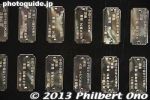
Closeup of old Nameplates of tournament winners that were on the Emperor's Cup.
|
|

Asashoryu gets thrown
|
|
|

Sumo match with kidsA retirement ceremony for an important sumo wrestler includes a variety of activities besides the actual ceremony of cutting away the topknot. It involves almost the entire Japan Sumo Association, and most wrestlers in the top three divisions (Makushita, Juryo, and Makunouchi) also appear in exhibition matches.
|
|

Plaques for the Three Outstanding Prizes (Technique, Outstanding Performance, and Fighting Spirit) awarded by two newspapers.Technique Prize (Gino-sho), Outstanding Performance (for most Yokozuna/Ozeki upsets, Shukun-sho), and Fighting Spirit (Kanto-sho).
|
|

Trophies for the Three Outstanding Prizes (Technique, Outstanding Performance, and Fighting Spirit) from the Japan Sumo Association.Technique Prize (Gino-sho), Outstanding Performance (for most Yokozuna/Ozeki upsets, Shukun-sho), and Fighting Spirit (Kanto-sho).
|
|

A "darn it" look on his face
|
|

The tournament winner receives numerous prizes from various organizations and companies.
|
|

A retirement ceremony for an important sumo wrestler includes a variety of activities besides the actual ceremony of cutting away the topknot. It involves almost the entire Japan Sumo Association, and most wrestlers in the top three divisions (Makushita, Juryo, and Makunouchi) also appear in exhibition matches.
|
|

Prize from Miyazaki Prefecture.
|
|

Prize from Fukushima Prefecture.
|
|

Mushrooms from Oita Prefecture.
|
|

Another prize from Fukushima Prefecture.
|
|
|
|
|

Prime Minister's Cup on left, the middle is the President Chirac Award from France, and the glass on the right is a prize from the Czech Republic.President Chirac is a sumo fan. There is also a Czech wrestler in the lower division.
|
|
|

Butsuri keiko
|
|

Prize from the United Arab Emirates.
|
|

The kids gradually get bigger.
|
|

Takamisakari for butsuri keikoEverybody cheered whenever he entered the ring.
|
|

In the back on the left is a prize from Mexico and one from Hungary on the right. In the front on the left is a prize from Mongolia, middle is from NHK, and right is from China.
|
|

Ozeki Musoyama is defeated.
|
|

Sumo museum
|
|

Asashoryu exchanges a few wordsAfter the practice was over at 11 am, the sole yokozuna went over to the council.
|
|

Sumo Museum. Open only during tournament days. Free admission.The wall on the left show portraits of all the yokozuna in the modern era.
|
|

Yobidashi wearing Aloha-print garb
|
|

Sumo service entrance for groups.
|
|

Finish, everybody out please...
|
|

Corridor and souvenir shops.A corridor encircles the arena.
|
|
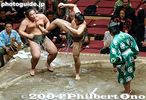
Comic sumo (shokkiri sumo)This is comedy time with two young wrestlers performing various comical antics (spitting at each other, kicking, and other illegal sumo acts) on the ring.
|
|

Sumo figurines.
|
|

Comic sumo (shokkiri sumo)This is comedy time with two young wrestlers performing various comical antics (spitting at each other, kicking, and other illegal sumo acts) on the ring.
|
|
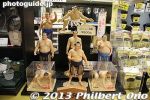
Sumo figurines.
|
|
|
|
|

Print Club photo sticker booth.
|
|

Kokugikan Cafe snack bar
|
|

Tidying up the ring
|
|

Bios and pictures of all sumo wrestlers in top Makunouchi division.
|
|

Musashimaru finally appears for a yokozuna belt demo
|
|

The bios and pictures are categorized according to prefecture. All wrestlers who were/are active in the modern era are introduced. Two wrestlers from Shiga Prefecture: Kurama and Misugisato.
|
|

Musashimaru acknowledges a spectator as he proceeds to the ring.This was a demonstration on how they tie on the thick, white rope (tsuna) around his waist. The tsuna is the symbol of the yokozuna. It takes several assistants to put it on. They are all wearing white gloves.
|
|

Non-Japanese sumo wrestlers who made it to Makunouchi Division. Four from USA (Hawaii), four from Mongolia, and one from Bulgaria (Kotooshu) as of 2006.
|
|

Yokozuna "tsuna" belt demo
|
|

Bulgaria (Kotooshu)
|
|

They wrap the rope around his waist from the front, or the thickest part of the rope.This was a demonstration on how they tie on the thick, white rope (tsuna) around his waist. The tsuna is the symbol of the yokozuna. It takes several assistants to put it on. They are all wearing white gloves.
|
|

Entrance to the dining room for chanko-nabe. It's downstairs in the basement.
|
|

Pulling it tight
|
|

The chanko-nabe menu changes a few times during the tournament. The recipes are from various sumo stables.
|
|
|

The banquet hall in the basement is used as a dining room during lunch time during tournaments. 大広間
|
|

Tying the rope at the back.
|
|

I usually eat two bowls. Only 250 yen per bowl.
|
|

Rear view of the shiranui style of tying the rope.He turned in all four directions to show everyone what it looked like. This is what is called the shiranui style of tying the rope. It is characterized by a single loop in the back. The other style, called unryu, has twin loops.
|
|

It is really good! Different flavors are offered during different days of the tournament. Top is shoyu (soy sauce) flavor, and bottom is salt flavor. Miso flavor is also offered.
|
|

Musashimaru goes back and then comes back...
|
|

Lecture classroom (previously used as a dining room for chanko-nabe during tournaments). 相撲教習所
|
|

Next to the chanko dining room is a sumo ring for practice and deliberation exhibition matches.
|
|

He performs his last yokozuna dohyo-iri ring-entering ceremony. He is flanked by Musoyama on the left as the sword bearer, and Miyabiyama on the right as the dew sweeper.
|
|

The sign reads "Physical body, Technique, Heart." What you need to succeed in sumo.
|
|

Musashimaru's final dohyo-iriHe could have had Yokozuna Asashoryu be either the sword bearer or dew sweeper, but he chose to have his stablemates to join his final dohyo-iri.
|
|
|

Musashimaru's final dohyo-iri
|
|

Door to arena.
|
|

Musashimaru's final dohyo-iri
|
|
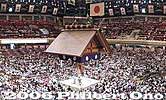
Panorama shot of sumo arena during a sumo tournament. There are two levels.
|
|

Musashimaru's final dohyo-iri
|
|

This is the lower level with zabuton box seats costing over 10,000 yen.
|
|

Musashimaru's final dohyo-iri ends
|
|

Box seats. Cramped space for four people.
|
|

He goes back to the dressing room
|
|

Box seat for two.
|
|

Sumo jinkuThey are singing sumo jinku, a chant-like song about sumo and sumo wrestlers. They are singing about Musashimaru and his career.
|
|

Sumo ring and suspended roof (no pillars).
|
|

Laying the red carpet for the main event.
|
|

Shinto-style roof. If the house is full, the "Full House" banners are rolled down above the roof. (Now rolled up.)
|
|

This must be a first, a kumu hula (hula teacher) from Hawaii performing on the sumo ring.He is Sonny Ching, a well-known hula teacher in Hawaii. He brought four male hula dancers who danced at the four corners of the ring.
|
|
|

Kumu hula Sonny Ching beats the ipu gourd drum, a traditional Hawaiian instrument. This must be a first, a kumu hula performing on the sumo ring in Japan.
|
|

Upper level and VIP booth.
|
|

Male hula dancer at one cornerThe original plan was for the hula dancers to perform on the ring itself. But at the last minute, Musashimaru decided that it was not appropriate so they danced outside the ring.
|
|

VIP booth or "Royal Box" where the Emperor and Empress (or Crown Prince and Princess) or head of state watch sumo.
|
|

Calling Musashimaru (with a conch shell)
|
|

Upper level seats.
|
|

Here he comes...
|
|

Upper level and giant sumo portraits of 32 past tournament winners. As of Jan. 2012, there are no portraits of Japanese sumo wrestlers. Only foreigners.
|
|

Head supporter speaks
|
|

Giant portrait of Yokozuna AkebonoThese are B/W photographs painted over with oil.
|
|

The chair
|
|

Giant portrait of Yokozuna Takanohana
|
|

The scissors (golden)I think it was given by French President Chirac who is a sumo fan.
|
|

Giant portrait of Yokozuna Musashimaru
|
|
|

Giant portrait of Yokozuna Asashoryu
|
|

Snip by actor Hiroshi Fujioka, who played Kamen Rider in the '70s.
|
|
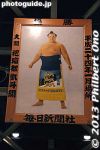
Giant portrait of Baruto
|
|

Giant portrait of Yokozuna Hakuho
|
|
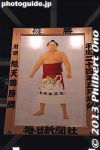
Giant portrait of Kyokutenho
|
|

Giant portrait of Harumafuji
|
|

Giant portrait of Ozeki Kotooshu.
|
|

Sumo scoreboard. The names of all the wrestlers are displayed in the order of the sumo matches (from right to left). The winner is indicated with a red lamp. Names of sumo wrestlers absent from the tournament (due to injury, etc.) are listed on the far le
|
|

Oh, I gotta take a picture of this...Look at the gyoji referee who must be thinking, "C'mon, hurry up!"
|
|

Snip by singer Shigeru MatsuzakiFamous for his classic hit, "Ai no Memory."
|
|

Konishiki is called and he enters
|
|

Snip and a hug by Konishiki (Question: Where was Akebono??)
|
|

Snip by Musashimaru's brother
|
|

More blood relatives (or brothers)
|
|

Snip by Kitanoumi, the head of the Japan Sumo Association
|
|

Snip by Yokozuna Asashoryu and a symbolic passing of the baton from one foreign yokozuna to the next (and only) foreign yokozuna.Mongolia's Golden Age of Sumo has begun.
|
|

Snip by stablemate Ozeki Musoyama
|
|

He was grim-faced all throughout
|
|

Panoramic shot of the KokugikanNotice the upper floor was quite empty, similar to Akebono's retirement ceremony.
|
|

Awaiting the final cut as we listen to one of his famous matches.
|
|

The final cut by stablemaster Musashigawa Oyakata.
|
|

Musashimaru minus his topknot
|
|

The End of Hawaii's Golden Age in sumo. For the first time since 1968, no wrestler from Hawaii is in the top Makunouchi division.
|
|

Nephews give a flower bouquet (they can step on the sumo ring)
|
|

His mom is next...
|
|

But his mom cannot step on the sumo ring...Females are prohibited from entering the sumo ring. Barring women from stepping onto the sumo ring, even to give an award to a wrestler, is one of the most blatant and preposterous forms of sexual discrimination in Japan. It was devised centuries ago, and for the sake of tradition, traditionalists in the sumo world have maintained this extremely absurd custom and belief that women are considered to be impure (due to menstruation). I'm not saying this as a gaijin (foreigner) who likes to criticize Japan or the Japanese. Nor am I saying this as a women's rights advocate. I say this from the standpoint of plain, old common sense.
Up to 1909, women were actually not allowed enter a sumo arena to view sumo matches. And once upon a time, women were prohibited from setting foot on sacred Mt. Fuji. Can you imagine if these traditions were still being practiced today?
Such discriminatory practices were abolished long ago, and here we are in the 21st century with women still unable to step into the sumo ring. The Japan Sumo Association has constantly rejected requests from important female ministers in the Prime Minister's Cabinet to give an award to the tournament winner in the sumo ring.
|
|

Musashimaru and his flowersThis was his last appearance at this retirement ceremony.
|
|

Makunouchi dohyo-iriNext was exhibition sumo matches by the top-division Makunouchi wrestlers. Musashimaru never appeared again.
|
|

Makunouchi dohyo-iri
|
|

Makunouchi dohyo-iri
|
|

Makunouchi dohyo-iri
|
|

Makunochi dohyo-iri ring-entering ceremony
|
|

Yokozuna Asashoryu performs his dohyo-iri ring-entering ceremony
|
|

Taiko drum demonstration
|
|

"Robocop" Takamisakari gets readyThe top-division Makunouchi wrestlers went through their matches quickly.
|
|

Takamisakari wins
|
|

Final match of the day with Yokozuna Asashoryu
|
|

Asashoryu in the face-off
|
|

Asashoryu later won
|
|

Yumitori-shiki bow-twirling ceremony
|
|

Exiting the building
|
|
|

Grand sumo tournaments are held six times a year in Jan., March, May, July, Sept., and Nov. They are held at Ryogoku Kokugikan arena in Tokyo in Jan., May, and Sept. In March, it is in Osaka, July in Nagoya, and Nov. in Fukuoka. This is the Kokugikan.
|
|

Each tournament is 15 days long, and each wrestler in the top two divisions wrestle once a day. A wrestler must win at least 8 times during a tournament to get promoted. Otherwise, he is demoted in rank. The more he wins, the higher he is promoted.
|
|

There are about 800 sumo wrestlers, called rikishi, and they belong to one of six divisions. Each day of the tournament starts in the morning with the lower divisions as you see here. They are skinnier and wear drab-looking black mawashi.
|
|

The sumo matches have five judges (shinpan), dressed in formal black kimono, sitting on each of the four sides of the sumo ring. There is also a referee (gyoji) on the ring. This is former yokozuna Takanohana who has lost much weight and looks like a kid.
|
|

One colorful highlight each day during a tournament is the dohyo-iri ring-entering ceremony performed by rikishi in the top two divisions. These are rikishi in the second highest division called Juryo. 十両
|
|

Juryo wrestlers performing the ring-entering ceremony.
|
|

The wrestlers are divided into east and west, and both groups perform the dohyo-iri. They wear colorful ceremonial aprons called kesho mawashi made of silk. They can cost up to 500,000 yen.
|
|

You can see sumo for as cheap as 2100 yen. You can buy tickets at the box office where the tournament is held. The cheap tickets may sell out, so go early.
|
|

JUryo wrestlers continue to fight.
|
|

This is Hakurozan, who was arrested for drug use in 2008 and booted out of sumo along with his brother Roho.
|
|

On the first day of the tournament, the chairman of the Japan Sumo Association (shown here is Kitanoumi) and top rikishi go on the ring to convey greetings to the crowd.
|
|

The chairman of the Japan Sumo Association (shown here is Kitanoumi) greets the crowd and thanks everyone for coming.
|
|

Next we have the ring-entering ceremony by the top division wrestlers in the Makunouchi Division. Rikishi from the east side come down the aisle first. They are led by a referee.
|
|

They enter as wooden clappers are clapped by someone.
|
|

The colorful kesho mawashi are expensive to make, and each wrestler has a sponsor who donates an apron. The sponsor's name is usually on the bottom.
|
|

The higher ranking rikishi are at the end of the line. (Hakuho and Kotooshu here).
|
|

They make their way around the ring.
|
|

The sumo tournaments are broadcast live every day on TV by NHK, focusing on the Makunouchi Division matches.
|
|

After the last wrestler is on the ring, they all turn around and raise their arms.
|
|

Getting off the sumo ring.
|
|

Ozeki Kotooshu.
|
|

Ozeki Kotooshu with an apron by Bulgaria Yogurt. (Kotooshu is from Bulgaria.)
|
|

Next are rikishi from the west side.
|
|
|

Takamisakari is one of the more popular rikishi.
|
|

Unfortunately, there are people ignorant of sumo who think it is just nearly naked, fat men charging at each other. Famous American newspaper columnist Mike Royko once wrote one of the worse and most insulting pieces about sumo in his column.
|
|

During a sumo exhibition tour in the US, first lady Nancy Reagan rejected having the yokozuna ring-entering ceremony performed in the Rose Garden of the White House. It was performed at the State Department instead with Secretary George Schultz attending.
|
|

Fortunately, there are many people who do appreciate sumo, like former French president Jacques Chirac. (THe current French president has no interest in sumo.)
|
|

Wrestlers wait until everyone is on the ring. Notice that Takamisakari (second from the left) and the rikishi on the far right have almost the same aprons. They will serve as the sword bearer and dew sweeper for the yokozuna ring-entering ceremony.
|
|

Some of the designs on the aprons are quite beautiful. Some are also pretty much advertisements for the sponsor who could be a support group, fan club, company, or rich individual.
|
|
|

Roho's apron actually had little lights which flashed.
|
|
|
|